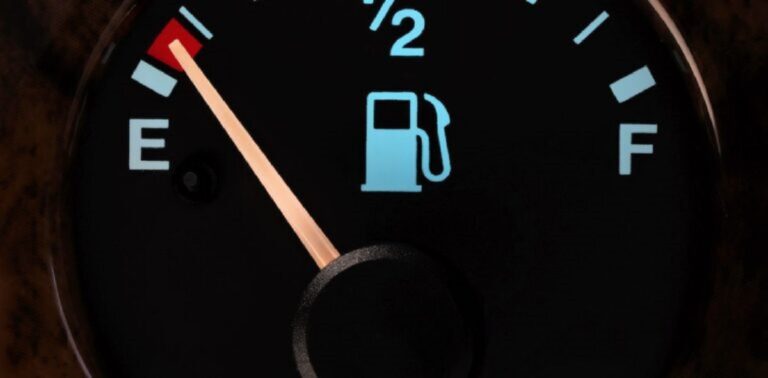Have you ever glanced at your fuel gauge, only to see the dreaded low fuel warning light flicker on? It’s a scenario many of us know all too well, prompting the inevitable question: How far can you really drive before your tank is completely empty? Let’s dive into the intricacies of your car’s fuel reserve, explore the factors that influence how far you can go, and share some tips to make those last few kilometers count.
Understanding Your Car’s Fuel Reserve
Think of the fuel reserve as your car’s safety net, a buffer designed to give you ample time to find a gas station before you’re left stranded. When your fuel gauge hits the “E” or that low fuel light comes on, you’re dipping into this reserve stash. Most modern vehicles are equipped with sensors that trigger this warning, providing you with a grace period to refuel.
The size of this reserve can vary significantly depending on your vehicle. Generally, it holds about 5% to 15% of your car’s total fuel capacity. For a more precise understanding, your owner’s manual is the best resource to determine the exact reserve capacity of your specific model.
I remember a rainy evening when my car’s fuel light flickered on. Thankfully, I was only a short drive away from the nearest gas station, but it was a stark reminder of how crucial understanding your fuel reserve can be.
Factors Affecting Distance on Fuel Reserve
Several variables can influence how far you can drive on your fuel reserve. Here are the key factors to consider:
Vehicle Type
Smaller, lighter cars typically boast better fuel efficiency compared to larger, heavier vehicles. This means you can often travel further on reserve fuel with a compact car than with an SUV or truck.
Fuel Tank Capacity
A larger fuel tank naturally means a larger reserve. If your car has a substantial tank, you’ll have more reserve fuel, allowing you to cover more kilometers before needing to refuel.
Fuel Consumption
Your vehicle’s fuel efficiency plays a significant role. Measured in liters per 100 kilometers (L/100 km), more efficient cars can travel further on reserve fuel. For example, a car that consumes 5 L/100 km will go farther on reserve than one that consumes 10 L/100 km.
Driving Conditions
The environment in which you’re driving also affects your reserve mileage. Stop-and-go city driving consumes more fuel compared to steady highway cruising. Additionally, harsh weather conditions like extreme cold or heat can decrease your fuel efficiency, reducing the distance you can cover on reserve.
Estimating Distance on Fuel Reserve
To estimate how far you can drive on your fuel reserve, you can use a simple formula:
Distance on Reserve = Reserve Capacity (in liters) x (100 / Fuel Efficiency)
For instance, if your car has an 8-liter reserve and consumes fuel at 6 L/100 km, the calculation would be:
Distance on Reserve = 8 liters x (100 / 6) ≈ 133 kilometers
Keep in mind that this is a rough estimate. Real-world conditions such as traffic, terrain, and driving habits can significantly impact this distance.
Tips for Maximizing Your Reserve Distance
Here are some strategies to help you make the most of your fuel reserve:
Drive Gently
Smooth acceleration and braking can significantly reduce fuel consumption. Avoid sudden starts and stops to help extend the distance you can travel on reserve.
Maintain Steady Speeds
Keeping a consistent pace, especially on highways, improves fuel efficiency. Use cruise control when appropriate to help maintain steady speeds.
Lighten Your Load
Extra weight demands more fuel. Clear out unnecessary items from your vehicle to reduce the load and stretch your fuel further.
Regular Maintenance
A well-maintained car runs more efficiently. Regularly check your oil levels, air filters, and tire pressure to ensure optimal fuel economy. According to the U.S. Department of Energy, proper maintenance can improve your gas mileage by an average of 10%.
I make it a habit to keep my car in top shape by following the manufacturer’s maintenance schedule. Not only does this save me money in the long run, but it also ensures I can maximize my fuel reserve when needed.
Avoid Relying Too Much on Your Fuel Reserve
While it might be tempting to push your fuel reserve to the limit, doing so regularly can lead to potential fuel system damage. Sediment and debris that accumulate at the bottom of the tank can clog your fuel pump and injectors, leading to costly repairs. It’s best to treat the reserve as a last resort and refuel as soon as possible to keep your vehicle running smoothly.
Final Thoughts
Understanding how far you can drive on your car’s fuel reserve empowers you to make informed decisions and avoid the stress of running out of gas unexpectedly. By considering factors like vehicle type, fuel efficiency, and driving conditions, you can better estimate your reserve distance and adopt habits that maximize your fuel economy.
Remember, while knowing your reserve capacity is helpful, regular refueling is the safest way to ensure you never find yourself stranded on the roadside. Keep your tank topped up, maintain your vehicle, and drive smart to enjoy a smooth and worry-free journey.
Happy driving!






